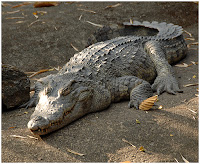Tanjung Puting National Park is located on the island of Borneo in the Kotawaringin Regency, Province of Central Kalimantan, the park is famous for its Orangutan conservation, composed of 415.040 hectares of dryland dipterocarp forest, peat swampforest, heath forest, mangrove and coastal beach forest, and secondary forest. Located at the geographical between 111o42' - 112o14' East and 2o33' - 3o32' South, Temperature 22o - 33o C, rainfall 2.400 mm/annual (on average).
 Tanjung Puting National Park is covered by complex mosaic of diverse lowland habitats. It contains 3.040 km2 of low lying swampy terrain punctuated by blackwater rivers which flow into the Java Sea. At the mouth of these rivers and along the sea coast are found Nipah/mangrove swamp. Mangroves teem with animal life. Tanjung Puting also includes tall dry ground tropical rain forest, primarily tropical heath forest, with a canopy of 30 metres (approximately 100 feet) with 'emergents' exceeding 50 metres in heigh, seasonally inundated peat swamp forest with peat in layers two or more metres (approximately 7 feet) deep.
Tanjung Puting National Park is covered by complex mosaic of diverse lowland habitats. It contains 3.040 km2 of low lying swampy terrain punctuated by blackwater rivers which flow into the Java Sea. At the mouth of these rivers and along the sea coast are found Nipah/mangrove swamp. Mangroves teem with animal life. Tanjung Puting also includes tall dry ground tropical rain forest, primarily tropical heath forest, with a canopy of 30 metres (approximately 100 feet) with 'emergents' exceeding 50 metres in heigh, seasonally inundated peat swamp forest with peat in layers two or more metres (approximately 7 feet) deep. In Tanjung Puting National Park, you will see the Orangutan, a lot of ex-captive Orangutan-rehabilitated in the park, you will also meet the king of this area, the largest and the oldest Orangutan who is still living in a wilderness of a national park.
In Tanjung Puting National Park, you will see the Orangutan, a lot of ex-captive Orangutan-rehabilitated in the park, you will also meet the king of this area, the largest and the oldest Orangutan who is still living in a wilderness of a national park.
The romantic forest, the romantic river and the romantic atmosphere of the park are also offer different experiences especially for those who want to have an adventurous honeymoon.
Among tree species commonly found are Ramin (Gonistylus bancanus), Jelutung, Kayu Besi / Iron Wood (Eusideroxylon zwagerri), Meranti (Shorea sp.), and Keruing (Dipterocarpus sp.), all of them have high value for industry. Other plants such as Bakung (Asian tricum), Pandan (Pandanus tectorius), Nipah (Nypa sp.), which growing on the riverside.
 The park is also rich in wildlife with the commonly seen is Orangutan (Pongo pygmaeus pygmaeus), the best known species that make the National Park best known, Proboscis Monkeys (Nasalis larvatus), a large monkey which is found only in Borneo, Long-tail Macaque (Macaca fascicularis).
The park is also rich in wildlife with the commonly seen is Orangutan (Pongo pygmaeus pygmaeus), the best known species that make the National Park best known, Proboscis Monkeys (Nasalis larvatus), a large monkey which is found only in Borneo, Long-tail Macaque (Macaca fascicularis).
Birds, especially Horn Bills, Kingfisher, Myna, Oriental Darter and over 220 bird species.
Furthermore, the list of fauna living in the park are include the occasionally can be seen : Agile Gibbon (Hylobates agilis), Grey Gibbon (Hylobates mulleri), Red-leaf Monkey (Presbistis rubicunda), Malayan Sun-bear (Helarctus malayanus), Wild Lige (sus barbatus), Estuarine Crocodile False Ghavial (Tomistoma schlegelli). The rivers together with the swamp and seasonal lake rookeries support the life of many spesies of fish that have very high values in term of ecology and economy.
 Tanjung Puting National Park located about 30 minutes to the right from the branch of Sekonyer River. Camp Leakey is in the national park in southern Borneo, and was set up in 1971 by Louis Leakey to support research activities in Tanjung Puting Wildlife Reserve. Louis Leakey was both teacher and mentor for three young primatologists who would go on to become known worldwide for their work with Chimpanzees and Gorillas respectively. The third, Birute Galdikas went on to become the Leading Authority of Orangutan and remains so to this day as President of the Orangutan Foundation International.
Tanjung Puting National Park located about 30 minutes to the right from the branch of Sekonyer River. Camp Leakey is in the national park in southern Borneo, and was set up in 1971 by Louis Leakey to support research activities in Tanjung Puting Wildlife Reserve. Louis Leakey was both teacher and mentor for three young primatologists who would go on to become known worldwide for their work with Chimpanzees and Gorillas respectively. The third, Birute Galdikas went on to become the Leading Authority of Orangutan and remains so to this day as President of the Orangutan Foundation International.
Camp Leakey also functions as Orangutan Rehabilitation Center. The camp and surrounding area is designated as a special utility zone. Over the years, the camp has served the research of several scientist and students. Tourist will be able to walk on certain trails of the trail system without disturbing the research activities. On the way to Camp Leakey (on Sekonyer Simpang Kanan River), you may occasionally see crocodiles and the false gavials.
Declare by Minister of Forestry No. 687/Kpts-II/1996, October 25, 1996.



















































